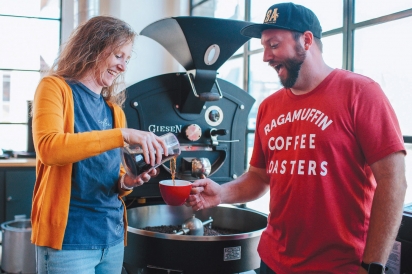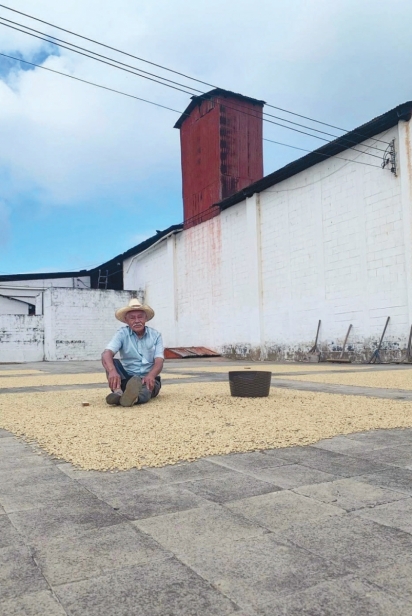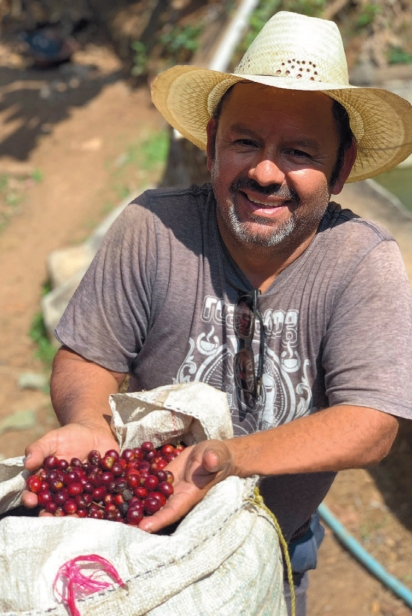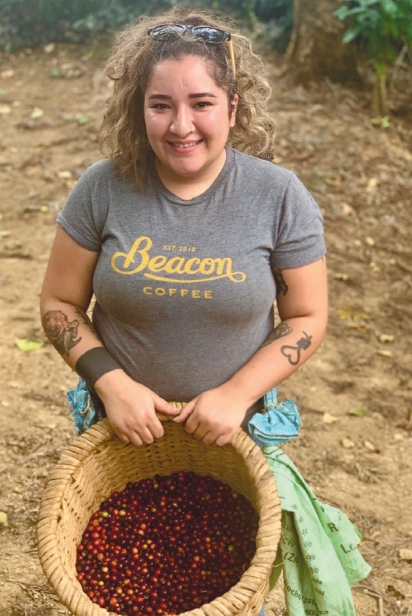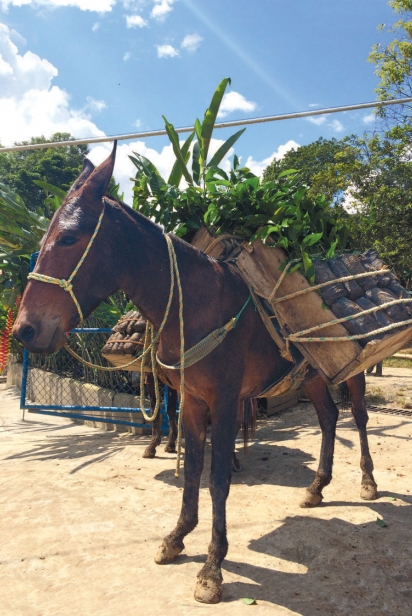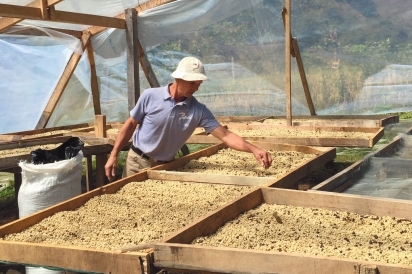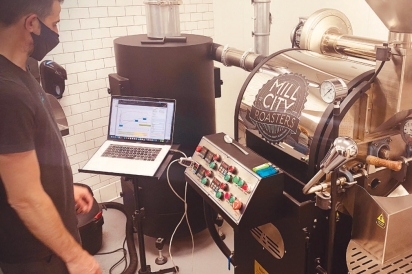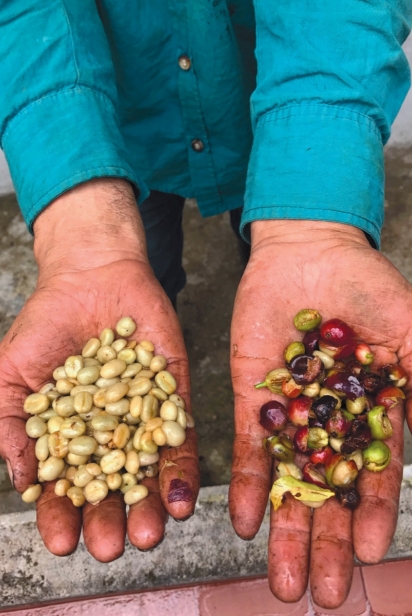Riding the Next Wave
Photos courtesy of Beacon Coffee, California Coffee Republic and Ragamuffin Coffee Roasters
Ventura County coffee trends
While we normally think of a wave as what goes under a surfboard, it is also a term to describe a trend. And coffee has a history with waves.
Legend has it coffee was first discovered by a goat herder in Ethiopia. By the 16th century it had become a staple in both homes and coffeehouses in the Near East. The drink rapidly spread from the Ottoman Empire to Europe with the help of Venetian traders. After more than a few failed attempts, Europeans eventually gained possession of fertile beans (a.k.a seeds) and the ability to establish their own coffee plantations. Fast forward to 1773 and the Boston Tea Party, when the palates of the people of the not-yet-United States switched to coffee, with some help from rebellion. By the 1800s, the Italians were working on espresso machines and Americans could buy pre-roasted coffee in paper bags.
Coffee, in the United States anyway, remained a mass-produced commodity primarily consumed at home. This was the first wave. The second wave arrived in the 1970s when franchises like Peet’s and Starbucks made getting coffee a cool thing to do. Since then, coffee—and the consumers’ relationship to it—has shifted dramatically.
THIRD WAVE COFFEE
Originally coined by roaster Trish Rothgeb, the term “third wave coffee” is often seen as a rebuke of the corporate coffee franchise. During this shift, coffee became a craft. Roasting was done in small batches by individuals with an intense focus on the coffee (its quality, where it was grown, how it was processed). Some of the passionate people doing the roasting also opened their own cafés where they could not just serve their coffee but also share their knowledge with their customers.
Suddenly there were more options in coffee preparation methods such as French presses and Chemexes (pour-over style brewers) and, more recently, cold brew. Cold brew’s specific preparation results in a more concentrated, naturally smoother, sweeter cup of coffee with less acidity and more caffeine and has become one of the hottest trends in the U.S. coffee market.
The coffee industry in general is expected to see a huge increase in sales derived from RTD (ready to drink) coffee beverages and it is largely cold brew that has led to this development.
FOURTH WAVE COFFEE
These days, the coffee industry is generally considered to be in its fourth wave. Sarah Pritchett, co-owner of Ragamuffin Roasters in Oxnard and Newbury Park, describes this wave as “a marriage between the creation of exceptional coffee products and an honest social consciousness.” Although that relationship began during the third wave, it has come to define the current approach to coffee, especially here in Ventura County.
FARMER CONNECTIONS
Responsibility, to both producers and consumers, has been a guiding principle of Beacon Coffee in Ventura and Ojai, which began roasting in 2010. Beacon’s direct partnerships with coffee estates and milling operations ensure the producers are being paid a fair and sustainable price. This in turn incentivizes them to grow exceptional coffee and makes them feel secure enough to experiment with farming techniques.
Beacon created a coffee subscription program in part to support some of the small family farmers they work with in Latin America. For farmers, experimenting with new techniques (either in what kind of coffee is grown or how it is processed) is a financially risky endeavor. That risk is made smaller by knowing there is a guaranteed demand for the results.
All of this gets lost in the process, of course, without consumer education. The desire to create a stronger connection between the producer and the consumer is what led John and Jennifer Wheir to start Beacon Coffee and, COVID aside, they have been cupping coffee with customers from the beginning. This allows coffee lovers to learn first-hand about the people and places that provide their coffee and understand the true value of what’s in their cup.
COMMUNITY CONNECTIONS
Sarah Pritchett says, “Coffee brings people together and creates community ... and as much as coffee is still a morning ritual to help wake us up for the day, it is even more so a point of connection.”
For Sarah and her husband, Shawn, co-owner and lead roaster, the pursuit of connection has naturally resulted in a collaborative approach to doing business in their community. Shawn is always looking to find ways to work with other businesses to create new coffee experiences and has partnered with local breweries and distilleries such as Topa Topa Brewing Co., Casa Agria Specialty Ales, Tarantula Hill Brewing Co. and Ventura Spirits. Sarah says she is especially looking forward to the early June re-release of Ragamuffin’s Strawberry Fields Forever, an Ethiopian Adado aged in Ventura Spirits’ strawberry brandy barrels.
These types of partnerships may become a key feature of fourth wave coffee. Will Sayre, co-owner with wife, Jen, of California Coffee Republic (CCR), located in The Alley in Moorpark, has successfully collaborated with Enegren Brewing in Moorpark on a German Coffee Porter and with Lucas Sellers Wine on a Guatemalan coffee aged in dried French oak LSW Grenache and Syrah barrels.
For Sayre, it all starts with ethically sourcing the best green coffee in a way that is traceable and documents a particular coffee’s history. He says he sees it as his mission within the marketplace to do “a fair amount of awareness and education work in a casual, approachable, ‘California chill’ way.”
The fourth wave has been described by some as “all about the science.” The fourth wave brought an emphasis on water minerality and temperature, grind sizes, extraction rates and filter selections. “Coffee is chemistry, and while I am committed to the chemistry of making excellent coffee, I understand that not every customer wants to spend the time learning all the complexities,” says Sayre. “It is important to me to approach the customer where they are at in their coffee journey and help them explore at their pace and level of enthusiasm. If they’d like to learn how to brew one of our coffees with a complex method at home, we are happy to help them with that.”
MAKING COFFEE HEALTHY
Something noticeable in cafés recently is the increased focus on health and the sudden incorporation of unexpected ingredients on the drink menu. It has become commonplace for cafés to offer superfoods like turmeric, beet root, mushrooms and moringa in lattes that now may or may not even have espresso.
Some cafés, like Longevity Coffee in Thousand Oaks, see coffee as a means for people to get needed nutrition. They serve an organic, vegan, keto-friendly Chaga Cappuccino with astragalus root and chaga mushroom and offer house-made almond milk. Rebecca Gauthier of Longevity sees coffee not as “an end in itself, but a means for consuming optimal nutrition.”
And speaking of milk, plant-based alternatives are clearly here to stay. The trend that began in 1997 with Starbucks’ soy latte has been almost taken over by oat milk. Available in the early 1990s, this alt milk has seen a boom in popularity (with sales of $29 million in 2019) due largely to millennial concern for the environment and a general shift to vegan diets.
CATCHING THE NEXT WAVE
Some industry leaders claim the fourth wave has already washed ashore and we are now seeing the approach of the fifth as characterized by the “scaling up” of the previous waves. This idea is evident in the corporate absorption of iconic independent third-wave industry leaders like Intelligentsia.
Started in 1995, Intelligentsia has been credited as the first to engage in direct trade and direct the spotlight to baristas with the first big public latte art throwdown. This iconic coffee institution is now owned by JAB Holding Company (which also owns Keurig, Panera Bread and Krispy Kreme, among other brands.) Similarly, Nestlé now owns a majority stake in the well-known chain Blue Bottle.
Regardless of whether we see a return to corporate coffee, the industry is still facing serious sustainability issues due in part to the extremely low price of coffee on the international market. Climate change, La Roya (a fungal disease called coffee rust,) and finding labor during a pandemic also make growing coffee an increasingly difficult endeavor. And according to Will of CCR, as far as industry trends go, better farming practices and new experimental processing methods are two that will impact coffee consumption the most in the coming years.


